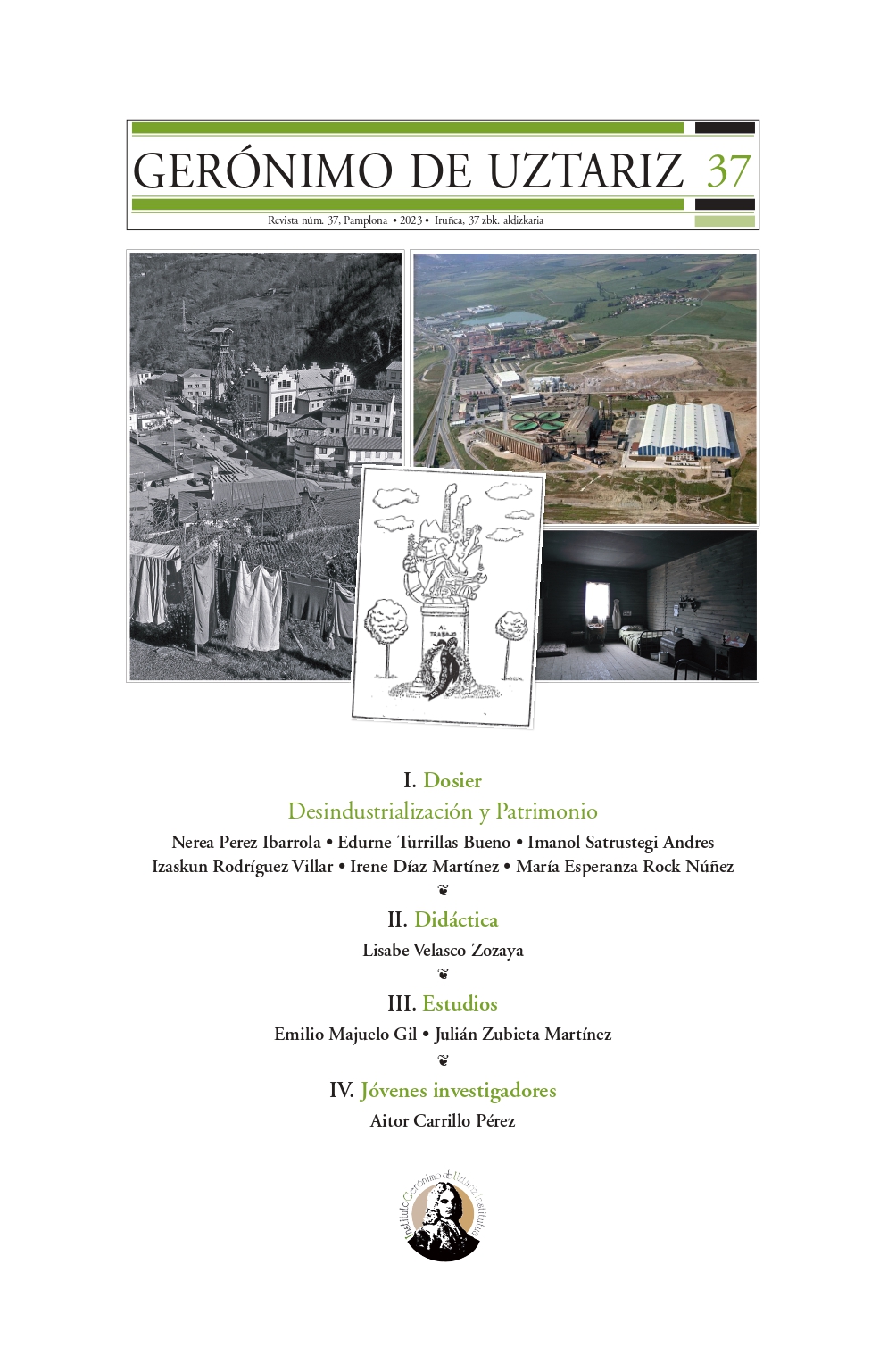The Inexhaustible Mine. Asturian Artists' Perspectives on Working Class Culture and (De)Industrialisation
Main Article Content
Abstract
The long process of decline and decline of mining in Asturias has generated a remarkable and varied cultural creation in the cultural sphere. Asturian artists have reflected in their works on the legacies of the workers' memory and the consequences of deindustrialisation. Thus, we can find discourses and narratives that move between disaffection, pessimism or criticism and the vindication of a workers' memory of struggle, mobilisation and social conquests.
This article aims to show and analyze, from a sociocultural perspective, the contributions of Asturian creators in the last years, emphasizing two dimensions that seem useful to understand the transition from industrial to post-industrial society: how culture has resignified the culture and memory of the working class, and the legacies of deindustrialization in Asturias. To do so, I will make use of the ideas of moral e and structure of feeling.
Article Details

This work is licensed under a Creative Commons Attribution-NonCommercial-ShareAlike 4.0 International License.
References
ABAD, E.¸ GARCÍA, C.; ERICE, F. (coords.) (2021). El antifranquismo asturiano en (la) Transición, Gijón: Trea.
APEL, D. (2015). Beautiful terrible ruins. Detroit and the anxiety of decline, Detroit, 2015, Rutgers University Press.
BYRNE, D. (2002). «Industrial culture in a post-industrial world: The case of the North East of England», City, Vol. 6, nº 3, pp. 279-289.
DÍAZ MARTÍNEZ, I. (2022). «Nostalgia del futuro. Narrativas posindustriales en las cuencas mineras de Asturias», Segle XX. Revista catalana d'història, nº 15, pp. 213-231.
DÍAZ MARTÍNEZ, I. (2018). «The Trauma of a Non-Traumatic Decline. Narratives of Deindustrialisation in Asturian Mining: The HUNOSA Case», BIOS –Zeitschriftfür Biographieforschung, Oral History und Lebensverlaufsanalysen, pp. 53-66.
DÍAZ MARTÍNEZ, I. (2017). «Octobre 1934. La rèvolution des Asturies» en Huitans de république en Espagne. Entre réforme, guerre et rèvolution 1931-1939, PressesUniversitaries du Midi, Toulouse, pp. 127-137.
DÍAZ MARTÍNEZ, I. (2013). «El enemigo a batir. La represión contra el movimiento obrero (1937-1943), en Rubén Vega García, (Coord.), El Movimiento Obrero durante el franquismo (1937-1977). Oviedo: KRK, pp. 151-170.
EDENSOR, T. (2005). Industrial Ruins. Space, aesthetics and materiality, New York, Berg.
GARCÍA GARCÍA, J. L., (2007). «Las fronteras del estigma. De mineros y prejubilados», en Manuela Cunha y Luis Cunha (Org.), Intersecçoes Ibéricas. Margens, passagens e fronteiras, 90 Grauss, Lisboa, pp. 227-249.
GARCÍA PIÑEIRO, R. (2008). Mineros, sindicalismo y huelgas. La Federación Estatal Minera de CC.OO. (1977- 1992). Oviedo: KRK/FJMZ.
GARCÍA PIÑEIRO R. (2001). «El declive de HUNOSA. Resistencia obrera y sindical al ocaso de la minería pública», en Carlos Arenas Posadas, Jerònia Pons Pons, Antonio Florencio Puntas (coords.), Trabajo y relaciones laborales en la España contemporánea, pp. 405-418.
GARCÍA PIÑEIRO, R. (1990). Los mineros asturianos bajo el Franquismo (1937-1962). Madrid: Fundación 1º de Mayo.
GUTIÉRREZ PALACIOS, R. (1990). Sociología del declive industrial: el caso de la minería europea del carbón. Trabajo para el concurso de una plaza de Catedrático del Área de Sociología de la Universidad de Oviedo.
GUTIÉRREZ PALACIOS, R. y GARCÍA BLANCO, J.M. (1990). «El declive de las áreas de antigua industrialización. Un análisis sociológico del caso asturiano». Sociología del Trabajo, nº 8.
KÖHLER, H.D., (Coord.) (1996). Asturias, el declive de una región industrial, Asturias, Trea.
LINKON, S., (2018). The Half-Life of Deindustrialization. Working-class writing about economic restructuring, University of Michigan Press.
MAH, A. (2012). Industrial Ruination, Community and Place. Landscapes and legacies of urban Decline.Toronto. Toronto University Press.
MAH, A. (2008). Landscapes and legacies of industrial ruination, London School of Economics and Political Science.
OJEDA, G. (1985). Asturias en la industrialización española, 1833-1907, Madrid, Siglo XXI.
ORTÚN SILVA, P. (2003). «La integración en la CECA y su repercusión para España», Papeles de Economía Española, nº 3, pp. 365-381.
PHILIPS, J. (2013). «Deindustrialization and the moral economy of the Scottish coalfields, 1947 to 1991», en International Labor and Working-Class History, 84 (1), pp. 99-115.
SANTULLANO, G. (1978). Historia de la minería asturiana, Oviedo: Ayalga.
SMITH, L. y CAMPBELL, G. (2017). «Nostalgia for the future: memory, nostalgia and the politics of class», en International Journal of Heritage Studies, vol. 23, nº 7.
THOMPSON, E. P. [1992] (2019). Costumbres en común. Estudios sobre la cultura popular. Madrid: Capitán Swing.
VÁZQUEZ, J. (1994). «La minería del carbón (1940-1967). Expansión y crisis», en Historia de la Economía Asturiana, Tomo III. Oviedo: Prensa Asturiana, pp.561-576.
VEGA, R y DÍAZ, I., (eds.) (2022). Desindustrialización: memoria, patrimonio, representaciones. Gijón: Trea.
VEGA, R. (2022). «Resignificando el pasado: memoria y creación cultural en Asturias», en DÍAZ, I. y VEGA, R. (Eds.), Desindustrialización: memoria, patrimonio, representaciones. Gijón: Trea, pp. 587-607.
VEGA, R. (2019). «Asturias: el reflejo del pasado industrial en la creación cultural», en Tébar, J. y Gimeno, J. (coords.). Restos y rastros. Memorias obreras, patrimonio y nuevos usos de los espacios industriales. Barcelona: Ediciones de Intervención Cultural / El Viejo Topo, pp. 65-83.
VEGA, R. (2018). «Looking back. Representations of the industrial past in Asturias», en Wicke, Christian, Berger Stefan, Golombek, Jana (Eds.), Industrial Heritage and Regional identities, London: Routledge, pp. 32-55.
VEGA, R. (coord.) (2013). El movimiento obrero en Asturias durante el franquismo, 1937-1977, Oviedo: KRK.
VEGA, R. y DÍAZ Martínez, I. (2013). «Conflictos obreros y movilizaciones sociales en el tardofranquismo y la transición (1965-1977) ». En VEGA, R. (coord.), El movimiento obrero en Asturias durante el franquismo, 1937-1977. Oviedo: KRK, pp. 309-370.

